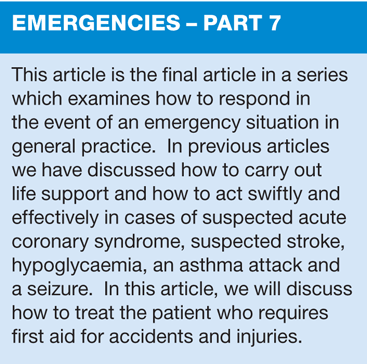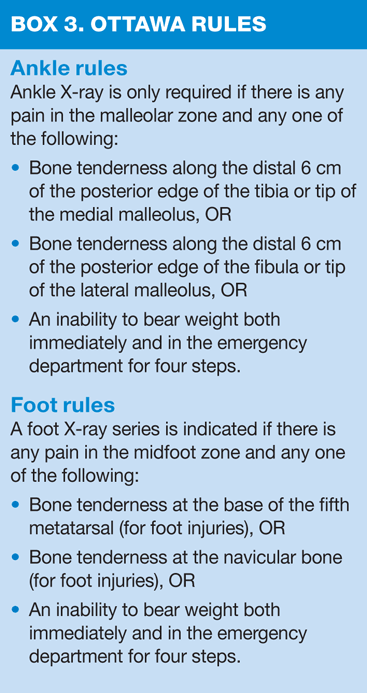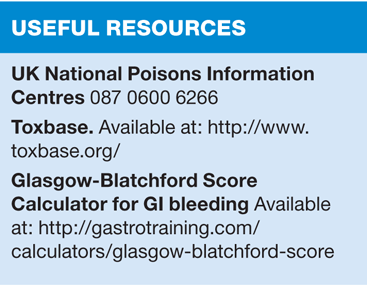Dealing with emergencies in general practice: First aid in general practice
From recent media coverage it would seem that patients take every minor ailment and injury to A&E, but in reality, many 'emergencies' present in general practice and the practice nurse needs to know what to treat in primary care and what to refer
In December 2012, the Royal College of General Practitioners (RCGP) launched its General Practice Nurse Competencies document,1 which brought together and updated previous models and frameworks, such as the Working in Partnerships Programme (WiPP). This document covers the wide scope of practice undertaken by a nurse working in general practice including the management of emergency situations, many of which we have covered in this series of articles. To complete the series, we will now consider the patient who presents with head injury, haemorrhage, poisoning, burns or suspected fracture. The RCGP document advises that practices have evidence-based practice protocols for dealing with these conditions and that nurses are able to assess the degree of urgency and take the necessary action. This article will provide some background and resources which may help practices to develop these resources.
It is important that general practice nurses are aware of guidance such as the RCGP guidance as many nurses may consider that these sorts of problems should immediately be sent to hospital. However, there have been some worrying headlines in the news recently about local Emergency Departments (EDs) being at bursting point as a result of too many people using it as their first port of call for any health-related issues. This puts enormous and unnecessary pressure on the service, which should be reserved for serious and potentially life-threatening events. The NHS Choices website describes A&E as being the place to go for
- Loss of consciousness
- Acute confused state and fits that are not stopping
- Persistent, severe chest pain
- Breathing difficulties
- Severe bleeding that cannot be stopped2
This means that other services can and should be used for less serious problems; these include minor injuries units, walk-in centres and of course, general practice. An ability to carry out an initial assessment and provide advice regarding immediate and ongoing management, including recognising when attendance at ED is indicated, is deemed to be part of the practice nurse's role in the RCGP document.
HEAD INJURY
NICE3 has produced guidelines on the management of head injury and these include pre-hospital management. The Glasgow Coma Scale (GCS) should be used to assess level of consciousness and a score of 8 or less should be communicated to ED prior to the patient's arrival.
The Glasgow Coma Scale, along with appropriate paediatric responses, can be accessed via http://www.patient.co.uk/doctor/glasgow-coma-scale-gcs
CT scans are the main investigation that will be carried out in head injury if indicated. A CT scan should be carried out within one hour in patients with head injury and the following features:
- GCS < 13 on initial assessment
- GCS < 15 when assessed in emergency department 2 hours after the injury
- Suspected open or depressed skull fracture
- Sign of fracture at skull base including haemotympanum (blood in the middle ear), periorbital bruising with bilateral 'panda eyes' being highly indicative of skull fracture, cerebrospinal fluid leakage from ears or nose or evidence of Battle's sign (bruising over the mastoid process)
- Post-traumatic seizure
- Focal neurological deficit
- More than 1 episode of vomiting
CT scans should be carried out within eight hours in patients with head injury who have amnesia of events more than 30 minutes before impact.
NICE also provides suggested written discharge note for adults and children post head injury, which could be amended for use in general practice.4
HAEMORRHAGE
Haemorrhage (bleeding) can be a minor or life-threatening event. When assessing a patient who presents with bleeding, it is important to ascertain the degree of bleeding and the cause of the bleed. NICE has produced specific guidance on assessing and managing heavy menstrual bleeding,5 and acute gastrointestinal bleeding.6 In the case of heavy menstrual bleeding, NICE advises that the clinician should take a careful history and carry out appropriate examination and investigations before a diagnosis is made and treatment prescribed. Each nurse should be aware of her own competencies in this field and should refer on to a GP or other appropriate health care professional accordingly.
Primary care assessment of patients with acute upper GI bleeding can be safely carried out using the Glasgow-Blatchford bleeding score (GBS).7 This tool can be used to identify those who require admission, and those who are at lower risk and less likely to require intervention; these patients can usually be managed as out-patients.
Other reasons why someone might present with bleeding in general practice include epistaxis, haemoptysis, rectal bleeding and bleeding as the result of injury — cuts and lacerations.
Epistaxis (nose bleeds) can be a medical emergency depending on the amount and length of bleeding. Most nose bleeds are minor and self-limiting with the correct approach to management however. A general assessment of blood pressure and pulse should be carried out and possible triggers, such as warfarin use or trauma, identified. If the patient is haemodynamically unstable referral to hospital should be arranged. Otherwise, first aid should be provided to stop the bleeding. The patient should sit upright and lean forward squeezing the soft part of the nose for 10-20 minutes to try to stop the bleeding. Cautery and packing may also be carried out in general practice by suitably trained people. However, if none of these interventions is adequate then referral to hospital should be arranged.8
Haemoptysis may be caused by cancer, tuberculosis and pulmonary embolism, among other conditions. It should always be taken seriously. A careful history should help to identify possible causes and dictate the appropriate line of investigation and/or referral.
Rectal bleeding may be due to something as relatively simple as haemorrhoids or to something as serious as bowel cancer. History (weight loss, constipation or change in bowel habit, for example) and examination will help to pinpoint possible causes, but the nurse should only work within her competencies in this respect and should always refer on to the GP or other suitable clinician if and when further assessment is required.
Lacerations are often seen in general practice. Bleeding may be present and should be stemmed using manual pressure, ensuring that all necessary precautions have been taken to protect both parties.9
POISONING
Poisoning can be accidental or deliberate, and can be caused by drugs, alcohol, plants or chemicals. If the individual is conscious, they should be asked to give as much information as possible about the substance concerned and the time and amount that was ingested or inhaled. Specific advice regarding poisons can be obtained via the UK National Poisons Information Centres on 087 0600 6266 or through Toxbase.10 Care should be taken to continually assess the patient's level of consciousness and arrangements made for them to be treated and managed in secondary care.
BURNS AND SCALDS
Burns and scalds are often seen in primary care as well as in ED. Burns are caused by dry heat sources such as fire or the sun whereas scalds come from wet heat such as liquids or steam. The NHS Choices website provides guidance on the management of burns including the types of burns which should be seen in ED.11 These include any chemical and electrical burns, large burns bigger than the size of a hand, any full thickness burn presenting with white or charred skin and any burns which present with blistering on the face, hands, arms, feet, legs or genitals. Children under 5 and pregnant women may also need to be seen in ED. Many burns can be dealt with by the individual at home or by the nurse in surgery. People who have suffered smoke inhalation and those who are having difficulty breathing following the incident where they sustained their burn should be referred to ED. In children, non-accidental injury should be considered.
First of all an assessment should be carried out of the patient's general status and then of the burn itself. The rule of nines (Box 1) can be applied when assessing the extent of the burn surface area.12 Box 2 shows definitions for assessing the severity of burns.
The primary management of minor burns consists of cooling, cleaning and protecting the burn. Cooling will be effective if undertaken within 20 minutes of the initial event. It is important when cooling to ensure this is done for long enough; burns will need 20-30 minutes of cooling to minimise damage and optimise healing. To cool the burn, running tap water is effective at stabilising the burn process, reducing oedema and relieving pain. The water should be cool or lukewarm, not ice cold. There is no need to apply ice or any creams or lotions. Any loose tissue should be bathed away but blisters should normally be left intact unless their position or condition suggests that sterile aspiration might be required. The burn can then be covered with a non-adherent dressing — cling film is recognised as being good for covering burns. Appropriate analgesia should be recommended and/or prescribed, and arrangements should be made to review the burn. The time that the burn was sustained should be recorded as damage can continue for the next 24-72 hours, and ongoing assessment should therefore be carried out. Burns always carry a risk of infection and antibiotics may be required.13
SUSPECTED FRACTURE
From this year, general practice nurse will be expected to assess patients for fracture risk using the Sheffield FRAX tool14 as part of QOF. However, they may also be involved in assessing people who may have sustained a fracture. Often suspected fractures require X-rays and expert assessment and ED attendance may be indicated. However, there are tools such as the Ottowa rules (Box 3) for suspected ankle fracture that allow injuries which are unlikely to be fractures to be identified, thus avoiding unnecessary referral and X-rays.15 Fractures occur when the continuity of the bone is disturbed. Observation, inspection and palpation form the mainstay of identification of possible fractures with key concerns being inability to use the part of the body affected, swelling, deformity and crepitus. Assessment strategies used will depend on the site affected. The most common type of fracture seen varies between age groups and genders and causes range from trauma to osteoporosis.16
CONCLUSION
In summary, practice nurses are well placed to offer first aid and emergency care in the primary care setting as long as they work within their competencies and recognise when it is appropriate to refer on to ED. The RCGP General Practice Nurse Competencies document gives a mandate for this and nurses who work to the standards within this document will help to ensure that emergency care is delivered appropriately.
REFERENCES
1. RCGP (2012) General Practice Nurse Competencies. Available at http://www.rcgp.org.uk/membership/practice-teams-nurses-and-managers/~/media/Files/Membership/GPF/RCGP-GPF-Nurse-Competencies.ashx
2. NHS Choices (2013) Emergency and Urgent Care Choices. Available at http://www.nhs.uk/NHSEngland/AboutNHSservices/Emergencyandurgentcareservices/Pages/AE.aspx
3. NICE (2007) Head injury. Available at http://guidance.nice.org.uk/CG56
4. NICE (2007) Head injury: suggested written discharge advice. Available at http://guidance.nice.org.uk/index.jsp?action=download&o=36265
5. NICE (2007) Heavy menstrual bleeding. Available at http://guidance.nice.org.uk/CG44/NICEGuidance/pdf/English
6. NICE (2012) Acute upper GI bleeding. Available at http://guidance.nice.org.uk/CG141/NICEGuidance/pdf/English
7. GP notebook (2013) Glasgow-Blatchford score. Available at http://www.gpnotebook.co.uk/simplepage.cfm?ID=x20090821174137923947
8. Bamimore O and Dronen SC (2013). Acute epistaxis. Available at http://emedicine.medscape.com/article/764719-overview#a1
9. St John Ambulance (2012) Bleeding. Available at http://www.sja.org.uk/sja/first-aid-advice/wounds-and-bleeding/bleeding.aspx
10. Bonsall A, Rull G (2011) Acute poisoning — general measures. Available at http://www.patient.co.uk/doctor/Acute-Poisoning-General-Measures.htm
11. NHS Choices (2012) Burns and scalds. Available at http://www.nhs.uk/Conditions/Burns-and-scalds/Pages/Introduction.aspx
12. Hettiaratchy S, Dziewulski P. ABC of burns BMJ 2004;328:1427. Available at http://www.burndoc.net/article_reprints/burns_-_general_article_fro.pdf
13. Alharbi Z, Piatkowski A, Dembinski R, et al; Treatment of burns in the first 24 hours: simple and practical guide by answering 10 questions in a step-by-step form. World J Emerg Surg. 2012 May 14;7(1):13.
14. Knis JA (2011) WHO FRAX: fracture risk assessment tool. Available at http://www.shef.ac.uk/FRAX/
15. Stiell IG, McKnight RD, Greenberg GH, et al. Implementation of the Ottawa ankle rules JAMA 1994;271(11):827—32.
16. Singer BR, McLauchlan GJ, Robinson CM, et al. (1998) Epidemiology of fractures in 15000 adults. Available at http://www.bjj.boneandjoint.org.uk/content/80-B/2/243.full.pdf
Related articles
View all Articles




